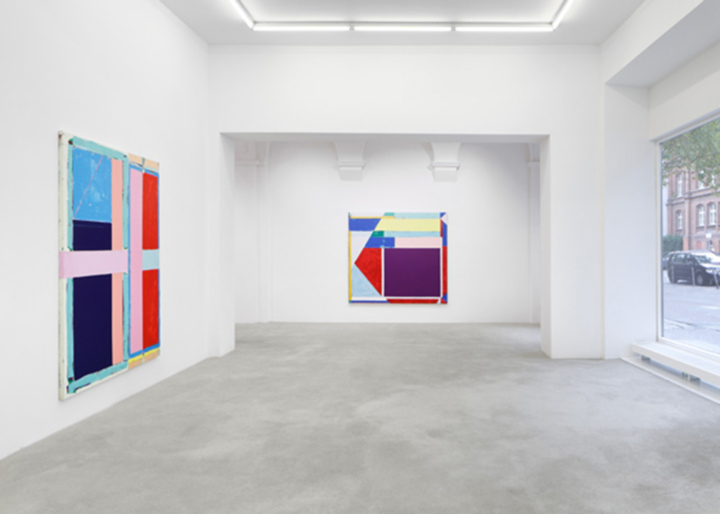The titles of Julia Rommel’s abstract paintings read like a trip down memory lane: Senior Year, Suburban Kids, and Rascals (all works 2018) are indicative of children testing the limits, or feasting on Fancy Cherries at fairgrounds — another title. Rommel’s bright color palette, which forms geometric planes, also plays into this rosy nostalgia. It’s only the title Ex-Husband that hits you in the stomach and throws the exhibition’s name, “Twin Bed,” into relief (note the singular suggesting one bed where people sleep apart). The nearly seven-by-seven-foot canvas includes two vast red rectangles — one fat, the other thin — divided by a blue border: two parts of a whole, now separated.
Taken at face value, Rommel’s paintings can be read as the result of yet another practice applying old-hat Greenbergian ideas of medium specificity and facture — work about the formal potential of abstract painting. She staples linens to stretchers, priming and painting before removing and restretching these on different frames, applying further paint and repeating the process on other structures. What results are varyingly sized, angular facets of color, often revealing the support and suggesting two-dimensional shapes moving in and out of three-dimensionality. For example, Happy Camper has rectangles of canary and lemon yellow underscored by baby blue, while Floater is a sea of lapis lazuli sliced through with planks of bubble-gum pink. They look like joyous harlequins, the texture of some sections smooth and thick, while others are dry and scrubby or even washy.

It’s the titles, and furthermore, the exhibition’s text written by Rommel, that lends another aspect to these works: one of storytelling beyond formal aesthetics. She describes her personal life: the “sadness coming in from the external world,” the momentary “good experiences” and the paintings being lively and thick when her intention was quick, thin, and light mark-making. Given that women artists continually struggle to be judged purely on their work, rather than biography or persona, this could play into a trap of feminizing abstraction, making it emotional. Indeed, this is what happens here: Rommel’s abstract paintings become about her life, her feelings — “women and their feelings!” people might shout as the gender binary digs its heels in. But everyone has feelings, whether they are taught to express them or not. The fact that Rommel pins hers to her practice with such honesty is as stirring and energizing as the work itself. I say: “Speak up and learn to listen!” — society needs it.



